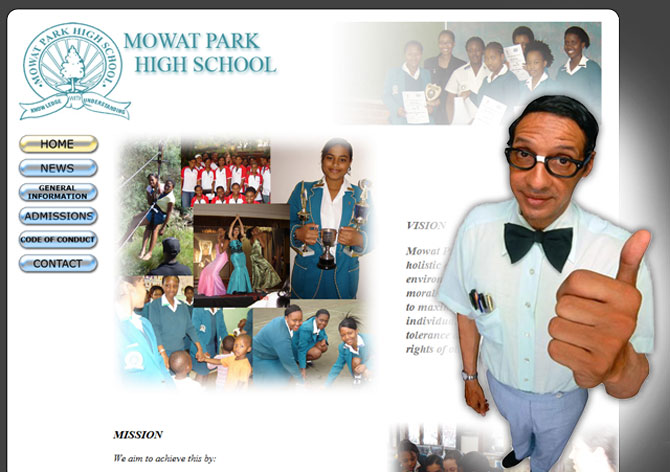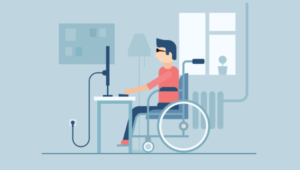It’s 2012 and the technological age is in full swing. Every person and his dog wants to take advantage of the Internet and the glorious opportunities that it presents us with. Unfortunately, what this means is that far too many people are branding themselves as “web designers”. Because there are no barriers to entry into the web design industry, this has resulted in a saturated market.
This is the story of how I entered the web design industry and, despite it being so overcrowded, how I made a success of my small design studio. Without trying to sound like a pompous primate, I would like to help further the web design industry by letting you in on, or reminding you of, three of the lessons that have kept me afloat in this competitive industry – lessons I had to learn the hard way.
Starting Out As a Web Design Wannabe
Picture this: A 15-year-old pale-skinned, pimple-faced teenager who believes he can accomplish anything. Through family connections, our brace-faced young hero gets the opportunity to design a website for a local school. He has no prior web design experience but is confident that his supreme skill in Space Invaders could translate into a great looking website!

The result?
As you have probably guessed by now, that naive young boy was, I’m ashamed to say, me. And that exemplary piece of art you see above was our first ever website.
Now you’re probably wondering how I went from that monstrosity to running an even remotely successful design studio. The truth is we didn’t. At least not immediately. It took a number of years and one sudden realisation before we could ever hope to succeed in an industry where practically everybody was better and more established than us.
Our sudden Realisation

After embarrassingly having decided that our first website was pretty darn awesome, and quite a bit of fun to create, my business partner – another spotty teenager – and I, decided we could totally start our own web design business. We were going to be millionaires!
For a few years after starting said web design business, we picked up the odd client (“relative” would probably me more apt) who was on a low budget and we thought we were doing rather well. We had discovered the magic of Content Management Systems and started creating terrific template-based websites. We didn’t care that they looked exactly like 431 other websites on the Internet. Nobody would ever know!
It wasn’t until a few years ago that we sat back and it dawned on us that we really weren’t making any impact on the market whatsoever. Our websites were mediocre. We had no real purpose. We were yet another boring “web design business” trying to take advantage of the technological age and consumer naivety.
Fortunately I tend to be a rather stubborn person. If I hadn’t given up after our first attempt at a website, I definitely wasn’t going to throw in the towel now. This prompted me to take a long hard look at what we were doing and why we weren’t doing well at all.
3 Key Lessons Learned
What followed was a period of intense self-examination. We closed up shop for around 6 months while we analysed everything we had done until that point and compared it with what the designers who were better than us were doing. We also did some research into other web designers who weren’t doing as well as they had hoped for.
Over time, we realised that we had made some critical errors in our initial endeavours into the web design world. We needed to adjust or we were going to have to shut down shop for good.
These are the things that we found successful web design agencies were doing around the world that we weren’t:
1. Stay Up To Date With Technologies and Trends

This is something I cannot stress enough. The number of self-acclaimed web designers (including ourselves) who were still designing websites using old coding techniques and technologies was astonishing.
It is vital that you keep abreast of the latest trends and technologies which are emerging in your industry. If not out of passion for your work, surely out of a need to survive? Mostly you will find that the news in your industry can really be quite exciting. I’m known by my friends to be able to rattle on for hours about the latest design and marketing trends. Do they care about what I have to say? Probably not. But your clients will.
With web design, the generally accepted practices change frequently. Browser architecture and support is updated almost daily. (Yes Mozilla, thank you for the 17th new version of Firefox this month.) You need to be adapting to this change.
HTML5 and CSS3 are fantastic developments and are being supported by an increasing number of browsers and devices. Mobile development and responsive design are some of the most talked about design trends in the last 6 months. If everybody else is talking and learning about these developments in your industry, shouldn’t you be too?
2. Differentiate Yourself from the Crowd

This is perhaps the most important thing I have learned about being in a competitive industry and marketing in general.
You need to make sure you stand out from the crowd. If you are doing the same thing as everybody else, the chance of a potential customer picking you out of the crowd is slim to none. If, however, you are doing at least one thing better than your competitors then you are giving clients a reason to choose you!
This one thing you do differently/better than other web designers is called your Unique Selling Proposition – a term you will likely hear marketers spray around generously. You could create your own USP by doing one of the following:
- Having the lowest price
- Having the highest quality product
- Excelling in areas where others fail (e.g. customer service)
- Targeting a specific niche exclusively
- Offering anything unique
In our case, we decided there were far too many general web designers and that we weren’t going to succeed by targeting anybody and everybody who needed a website. We decided that the way forward was to specialize in creating websites and branding for a specific target market/group of people.
Because my passion lies in small business and entrepreneurship, I decided that I wanted to target the small business/entrepreneurial niche. While every other designer was offering web design to every person who needed a website, we focused on making sure that our entire business model was crafted in order to make sure that we were the best web designers when it came to creating websites for a new startup or small business.
The results were astounding. We have become known over time as the go-to guys for new business branding and websites and that is exactly what you want to achieve in order be memorable and successful in a competitive market. If potential clients remember you as a solution to a specific problem of theirs, you are going to bring in a whole lot more business than you would have, had you not decided to be different.
To sum up: Establish your business’ USP. Make sure your clients know what that USP is. Profit.
3. Under-Promise and Over-Deliver

This is something I have learned more over time since we reinvented our design studio and business model. Once we were actually bringing in clients, the concept of under-promise, over-deliver became a lesson that has served me well each and every day when dealing with those clients.
Advertising in the web design niche is expensive. If you’ve run an Adwords campaign targeting keywords in the web design field, you will know this all too well. It stands to reason, then, that you would want as much word of mouth advertising as possible. Right?
How did we begin generating an enormous amount of word of mouth referrals? By exceeding customer expectations, each and every time.
It is human nature to want to tell your friends and relatives about something truly great. If you are over-delivering on your clients’ expectations, you can be sure that somebody is going to hear about the amazing customer service they received or the top quality product they got for a really low price, or the free logos you designed for them along with their websites.
I’m sure you can understand why this concept is so effective, so why not put it into practice? I’m sure you will see great results, just as I have.
Ending Up as a Successful Web Designer

After months of self examination, research and brainstorming, we reinvented our business completely. We adopted an all new image, work ethic and philosophy as we set out on our mission to become the small business branding and web design authority in our industry.
It would be amiss of me to say that we have achieved this goal, or that we are even close to achieving it. We have, however, transformed our web design business from something mediocre into a quality service that people are willing to pay good money for. The 15-year-old web design wannabe progressed into a successful web designer by incorporating, inter alia, three important lessons into his web design service:
- Always keep learning. Don’t rest on your laurels!
- Establish a USP. Be different from your competitors.
- Under-Promise. Over-deliver. Always exceed expectations!
These are all things that can be done without spending a single additional cent. There is no reason why you shouldn’t begin doing all three of the things I’ve spoken about above and absolutely no reason why you can’t be a successful web designer as a result.
Sometimes all it takes to be successful is for a person to swallow his pride and improve what he has to offer.
Thumbs up image via ShutterstockFrequently Asked Questions (FAQs) about Becoming a Successful Web Designer
What are the essential skills required to become a successful web designer?
To become a successful web designer, you need a combination of technical and soft skills. Technical skills include proficiency in HTML, CSS, JavaScript, and knowledge of design software like Adobe Photoshop and Illustrator. You should also have a good understanding of UX/UI design principles, responsive design, and SEO fundamentals. Soft skills include good communication, problem-solving abilities, creativity, and a keen eye for detail. Staying updated with the latest web design trends and technologies is also crucial for success in this field.
How important is a formal education in web design?
While a formal education in web design or a related field can provide a solid foundation, it’s not always necessary. Many successful web designers are self-taught or have learned through online courses and tutorials. What’s more important is your portfolio, which showcases your skills and creativity. Employers and clients are more interested in what you can do rather than your educational qualifications.
How can I build a strong portfolio as a web designer?
A strong portfolio is crucial for showcasing your skills and attracting potential clients. Start by working on personal projects or offering your services to non-profit organizations or small businesses. Include a variety of work in your portfolio to show your versatility. Make sure to present your projects in a way that highlights your design process, problem-solving abilities, and the results achieved.
How can I stay updated with the latest web design trends and technologies?
The web design field is constantly evolving, so it’s important to stay updated. You can do this by following industry blogs and websites, attending web design conferences and meetups, taking online courses, and participating in web design communities and forums. Experimenting with new tools and technologies on your own projects can also help you stay ahead of the curve.
What is the role of SEO in web design?
SEO plays a crucial role in web design. A well-designed website is not just visually appealing but also optimized for search engines. This includes using SEO-friendly URLs, ensuring fast loading speed, making the website mobile-friendly, using proper heading tags, and including meta tags for each page. A good understanding of SEO can give you an edge as a web designer.
How can I improve my communication skills as a web designer?
Good communication is key to understanding client needs and delivering successful projects. You can improve your communication skills by actively listening, asking clarifying questions, providing regular updates, and explaining your design decisions in a clear and concise manner. Participating in public speaking events or joining a local Toastmasters club can also help improve your communication skills.
How can I differentiate myself from other web designers?
To stand out from other web designers, focus on developing a unique style and personal brand. Showcase your unique skills and strengths in your portfolio. Specializing in a particular niche or industry can also help you stand out. Providing excellent customer service and building strong relationships with your clients can also set you apart.
How important is networking in the web design industry?
Networking is very important in the web design industry. It can help you learn from other professionals, stay updated with industry trends, find new clients, and even land job opportunities. You can network by attending industry events, participating in online communities, and connecting with other professionals on social media platforms like LinkedIn.
How can I handle difficult clients as a web designer?
Dealing with difficult clients can be challenging, but it’s part of the job. The key is to remain professional, patient, and empathetic. Clearly communicate your design process, timelines, and deliverables from the start. If conflicts arise, try to understand the client’s perspective and find a mutually beneficial solution.
How can I continuously improve as a web designer?
Continuous learning and improvement are key to success in the web design field. Always be open to feedback and willing to learn from your mistakes. Take advantage of online courses, tutorials, and resources to learn new skills and improve existing ones. Experiment with new tools and technologies, and don’t be afraid to step out of your comfort zone.
Mark runs a design studio in Durban, South Africa. He is a web designer and branding expert for small businesses and entrepreneurs. Connect with Mark on Google+.



